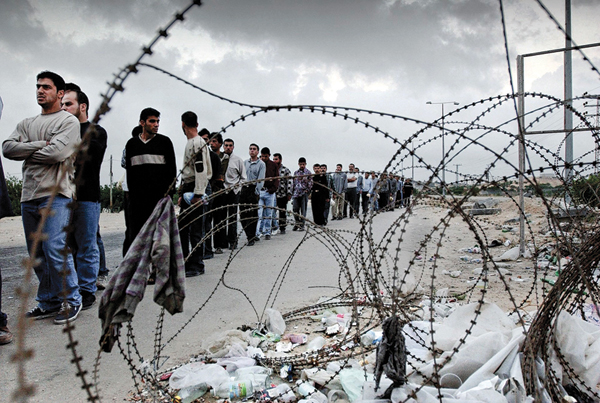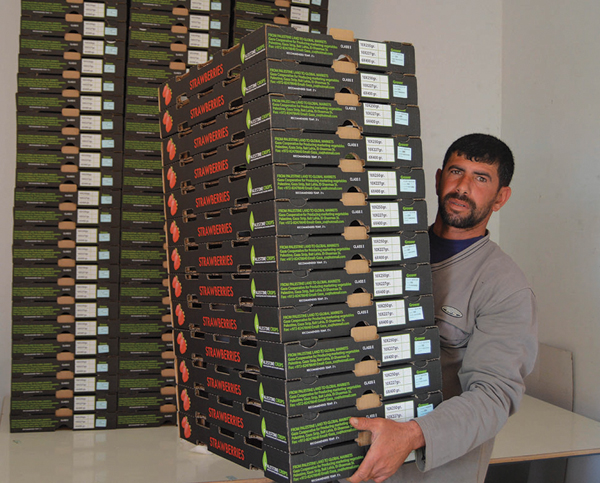
This article examines the economy of the Occupied Palestinian Territories (OPT) following the 1967 occupation within the analytical framework of settler-colonialism.i Indeed, the occupation was only a continuation of the Zionist settler-colonial project. Israel’s control over the OPT has been colonial because it involves a foreign entity that is seeking to appropriate the land of the indigenous population and establish a new colonial society. It has also been based on the disarticulation of the OPT economy, making it heavily dependent on the Israeli economy and thus preventing Palestinian independence and sovereignty.ii
What are the structural mechanisms of Israeli colonial control and how has the relationship between the Israeli economy and the OPT economy changed over the years?
Limited economic integration of the OPT into the Israeli economy (1967–1993)
After the occupation in 1967, Israel sought to incorporate the OPT economy into the Israeli economy in such a way as to allow for maximum expropriation of land, while precluding Israeli dependence on cheap Palestinian labor.iii However, as a result of the manner in which the system was implemented, the OPT economy became heavily dependent on the Israeli economy.
Trade and labor constituted the two main pillars of partial economic integration. In the area of trade, Israel imposed a one-sided customs union on Palestinians. In theory, a customs union is an economic agreement among countries in which the parties allow for free trade of goods within the union, and agree on a common external tariff with regard to imports from the rest of the world. However, in practice, only one side – Israel – dictated the terms of the trade arrangement to meet its own needs.
For example, while Israeli products had free access to the Palestinian market, Palestinian goods had very restricted access to the Israeli market. Israel also protected itself from certain Palestinian goods, especially in the area of agriculture.iv In addition, the trade arrangement raised tariffs approximately fourfold, thus redirecting OPT trade away from neighboring Arab countries and the rest of the world toward the Israeli market.v
Consequently, the OPT economy became dependent on the Israeli economy in the area of trade. The Palestinian market was a captive market for Israeli products, especially given the absence of economic borders between the two economies and the low transportation costs. For instance, in 1984, imports from Israel accounted for 88 percent of WB imports.vi Moreover, as Palestinian producers lost their competitive edge in international markets and faced fierce competition from advanced Israeli manufacturers, Palestinian production and exports stumbled. A large trade deficit was thus characteristic of this period as export growth was well below import growth.vii
This negative trade balance was largely financed by income from Palestinian workers in the Israeli market. In fact, the incorporation of Palestinian labor into the Israeli economy was another key factor in integrating the OPT economy into the Israeli economy.
Between 1967 and 1990, 35 to 40 percent of the employed Palestinian labor force worked in Israel.viii They generated more than 25 percent of the OPT gross national product and contributed to the doubling of per capita income between 1970 and 1987.ix However, the increase in income was accompanied by a decline in the productivity of the OPT economy that was due to several factors: stagnation of industrial production; decrease in cultivated areas; low investment in productive assets; and Israeli-imposed obstacles on the development of Palestinian enterprises that might compete with Israel.x
The limited imposed economic integration, through trade and labor, made any Palestinian economic “growth” skewed since it was linked to Israeli rather than to Palestinian demand and supply, and was conditioned on access to the Israeli labor market and other external sources of income. Furthermore, the above-described system led to the transfer of substantial resources from the OPT economy to that of Israel.xi First, there was no agreement in the customs-union arrangement on sharing the proceeds from import taxes, which were largely transferred to Israel. The second source of revenue to Israel was from income tax and social security paid by Palestinian workers in Israel. The third was the seigniorage revenue, i.e., the revenue earned by the money-issuing authority – Israel – since the Israeli shekel was made legal tender in the OPT.
This drain of revenues was exacerbated by Israel’s expropriation of Palestinian economic resources and factors of production, especially through the illegal settlement enterprise. According to the UN Conference on Trade and Development (UNCTAD) (1996), by 1992, 68 percent of the total land of the West Bank and 40 percent of that of Gaza was no longer under Palestinian use or control because of Israel’s confiscation policies.xii
As a result, by 1993, the OPT economy was structurally weak, imbalanced, and heavily dependent on the Israeli economy. It was already in a state of de-development.xiii
The Oslo Accords (1993/1995): Entrenching a crippling colonial dependency
As part of the Oslo Accords, the 1994 Paris Protocol codified the financial and economic relations between the Palestinian Authority and Israel. These accords have only deepened the structures of Israel’s colonial occupationxiv by strengthening Israel’s domination over the OPT and increasing Palestinian dependency on the Israeli economy, while denying Palestinian sovereignty and self-determination.
In the area of trade, the post-Oslo period was very similar to the pre-Oslo period. The Paris Protocol established a quasi customs union. Why a customs union and not a Free Trade Area as Palestinians initially wanted? Because only a customs-union arrangement would allow Israel to postpone the issue of borders and thus the controversy between separation and integration. In fact, a customs union entails neither the demarcation of internal borders and thus the establishment of a sovereign Palestinian economic and political entity nor the total elimination of borders or integration. It is thus completely in line with Israel’s “no-state solution” strategy.xv This explains why the continuation of Palestinian labor flows to Israel was conditioned on Palestinians’ acceptance of a customs-union arrangement.xvi
As in the pre-Oslo period, the customs union was one-sided since the trade policy (customs rates and other regulations) of Israel was imposed upon the OPT (apart from specific goods in the so-called lists A1, A2, and B). The arrangement has also allowed for unrestricted flow of Israeli goods into the Palestinian market, while severe restrictions were imposed on the movement of Palestinian goods between the OPT and Israel and within the OPT. Consequently, the Palestinian market remained a captive market for Israeli goods. According to UNCTAD (2016), Israel has recently accounted for more than 70 percent of Palestinian imports and 85 percent of Palestinian exports.xvii
While trade in the post-Oslo period played a similar role compared to the pre-Oslo period, labor flows did not have the same integrating role as during the pre-Oslo period. Labor arrangements were determined by Israel’s attempts to redefine its territorial and economic borders with both the West Bank and the Gaza Strip.xviii In the case of the West Bank, Palestinians still had access to the Israeli labor market, reflecting Israel’s strategy to incorporate parts of the West Bank while avoiding a demarcation of borders. However, in the case of the Gaza Strip, restrictions on labor flows indicate the move towards separation between Israel’s and Gaza’s economies.
The above short analysis of the Paris Protocol highlights that economic arrangements with the Palestinians have been largely shaped by Israel’s political interests and territorial considerations. While a Palestinian Authority was created, the Oslo Accords have led to the fragmentation of the Palestinian body politic and have entrenched Israel’s colonial domination over the OPT. The Paris Protocol deepened Palestinians’ dependency on Israeli trade, monetary and fiscal policies and gave Israel control over labor movement and Palestinian fiscal revenues, while conditioning any possible limited economic development to Israel’s security and territorial concerns.xix Meanwhile, the “Palestinian economy” has become restricted to the West Bank and Gaza Strip, corresponding to the future aspired borders of the Palestinian nation-state. Palestinians have also become increasingly dependent on donor aid, which has surged since Oslo. An “accelerated de-development process” thus ensued.xx
The economic bantustanization of the OPT (2000–today)
The closure regime has been a major economic aspect of the post-Oslo period. Since the 1990s, Israel has severely restricted the Palestinians’ freedom of movement and access in the Occupied Palestinian Territory through a hermetic system of physical, administrative, and institutional obstacles. Fixed and flying checkpoints, roadblocks, earth mounds, road gates, permit requirements, and the Wall, have become the dominant practices of the occupying authorities in the OPT, with deleterious effects on the movement of persons/workers and goods within the OPT as well as to/through Israel.
Closure policies went hand in hand with more expropriation of Palestinian land through the expansion of illegal settlements and the construction of the Wall, among other measures. The ensuing territorial fragmentation of the OPT was accompanied by the political polarization of Palestinian society, especially following the split between the Fatah-led Palestinian Authority (PA) in the West Bank and the Hamas-led government in the Gaza Strip. Political disintegration went hand in hand with economic fragmentation, to the extent that it is more relevant nowadays to speak of Palestinian “economic regions” or fragments instead of “a Palestinian economy.”xxi
♦ While the 1994 Paris Protocol forms the most important basis for Palestinian economic transactions and secures the economic viability of the Palestinian State, it has also entrenched the structures of Israel’s colonial occupation and Palestinian dependency on Israeli trade, monetary, and fiscal policies by giving Israel control over labor movement and Palestinian fiscal revenues, while conditioning any possible limited economic development on Israel’s security and territorial concerns.
The future: New economic warfare?
Against this background, the main question is: What can be done in the future? What can we learn from history, especially from the first Intifada?
The Intifada of stones, which erupted in 1987, took the form of civil disobedience and economic resistance. It connected economic activity to political vision and saw economic liberation and independence as necessary for political liberation. Economy was seen as a tool to help achieve social and national goals.xxii
Fostering Palestinian productive capacity and self-reliance was at the core of economic resistance initiatives during the Intifada. A network of grassroots committees was thus established to emphasize production over consumption and provide agricultural training and education campaigns to help families plant their gardens. Committees, such as the Palestinian Agricultural Relief Committee (PARC), played a large role in spreading backyard gardens and household economies. The goal was to help establish an economy that was no longer dependent on the Israeli economy.
Widespread boycotts of Israeli products also took place and began with cigarettes and drinks. As a result, Palestinian production of cigarettes increased by 25 percent in a month. Meanwhile, Israeli trade with the Palestinians declined by more than US$ 50 million per month – a drop of 63 percent.xxiii

Palestinians also employed tax resistance by withholding tax payments that were largely used to fund the occupation. Beit Sahour was one of the leading towns that refused to pay taxes. In addition, Palestinian shops and businesses were closed in partial and general commercial strikes (including in the 1948 territories). Many Palestinian workers also resigned from their jobs in the Israeli market, in an effort to paralyze the machine of Israeli production. Israeli businesses faced many losses, especially in agricultural projects, textile production, and the construction and services sectors. Palestinian businessmen played an important role by decreasing commodity prices and employing more workers although they did not need them. However, despite these collective actions of economic resistance, grassroots committees failed to build an alternative popular system to replace the colonial one.xxiv
Is such economic warfare possible at the moment given the current weakness of grassroots and mass-based movements and the absence of a political and economic leadership that unifies all Palestinians?
An economic strategy of resistance is possible and certainly necessary. Economy should be used as an instrument in a future counter-hegemonic strategy of resistance to Israel’s settler-colonial project and its power structures. Indeed, our struggle is an anti-colonial struggle and should not be limited to a nation-state project. The “Palestinian economy” should thus transcend the nation-state model, restricted to the West Bank and the Gaza Strip, and should at least incorporate the economy of the 1948 territories. However, this calls for a new leadership with a new vision and a new strategy.
» Nur Arafeh is the Policy Fellow of Al-Shabaka: The Palestinian Policy Network, and a researcher in economic development. She has a dual BA degree in political science and economics from the Paris Institute of Political Studies – Sciences Po and Columbia University, and holds an MPhil degree in development studies from the University of Cambridge. She will start her doctoral studies as a Rhodes Scholar at the University of Oxford in October 2017.
i. According to Patrick Wolfe, settler colonialism involves a “logic of elimination,” which “strives for the dissolution of native societies” in order to establish “a new colonial society on the expropriated land base.” Patrick Wolfe, “Settler colonialism and the elimination of the native,” Journal of Genocide Research, Vol.8, No.4, 2006, pp. 387–388.
ii. Leila Farsakh “The Political Economy of Israeli Occupation: What is colonial about it?” Electronic Journal of Middle Eastern Studies, No.8, 2008.
iii. Ibid.
iv. Arie Arnon, “Israeli Policy Towards the Occupied Palestinian Territories: The economic dimension, 1967–2007,” Middle East Institute, 2007.
v. Fadle Naqib, “Economic Aspects of the Palestinian-Israeli Conflict: The collapse of the Oslo Accords,” World Institute for Development Economics Research, 2002.
vi. Antoine Mansour, “The West Bank Economy: 1948–1984,” book chapter in The Palestinian Economy, edited by George T. Abed, 1988.
vii. Ibid.
viii. Leila Farsakh, “Palestinian Economic Development: Paradigm shifts since the first Intifada,” Journal of Palestine Studies Vol. XLV, No. 2, Winter 2016.
ix. Farsakh, 2008. Op. Cit.
x. Mansour, 1988. Op. Cit.
xi. Naqib, 2002. Op. Cit.
xii. UNCTAD, “Prospects for Sustained Development of the Palestinian Economy: Strategies and policies for reconstruction and development,” 1996.
xiii. According to Roy, “prior to Oslo, Palestinian economic de-development was advanced by a range of policies that together effectively precluded the kind of indigenous economic and institutional change necessary for structural transformation and capital accumulation.” “De-development Revisited: Palestinian economy and society since Oslo,” Sara Roy, Journal of Palestine Studies, Vol. XXVIII, No. 3, Spring 1999.
xiv. Adam Hanieh, “The Oslo Illusion,” Jacobin Magazine, 2013.
xv. Amal Ahmad, “The Customs Union & Israel’s No-state Solution,” Al-Shabaka: The Palestinian Policy Network, 2014.
xvi. Arnon, 2007. Op. Cit.
xvii. UNCTAD, “Report on UNCTAD Assistance to the Palestinian People: Developments in the economy of the Occupied Palestinian Territory,” 2016.
xviii. Leila Farsakh, “Palestinian Labor Flows to the Israeli Economy: A finished story?” Journal of Palestine Studies XXXII, no. 1, Autumn 2002.
xix. Farsakh, 2008. Op. Cit.
xx. Roy, 1999. Op. Cit.
xxi. For more on the economic fragmentation of the OPT, please read: “Strengthening Trade and Economic Interaction Between Palestinians in the West Bank and Inside Israel: An Arab “north-north” alternative to Israelization,” Raja Khalidi and Qossay Alsattari, Centre for Development Studies, Birzeit University, 2015.
xxii. Adel Samara and Odeh Shehadeh, Al-Himayah al-Sha’biya, 1988.
xxiii. Judith Gabriel, “The Economic Side of the Intifadah,” Journal of Palestine Studies, Vol. 18, No. 1, Autumn 1988.
xxiv. Linda Tabar, “People’s Power: Lessons from the first intifada,” book chapter in Critical Readings of Development under Colonialism, Centre for Development Studies, Birzeit University, 2015.


